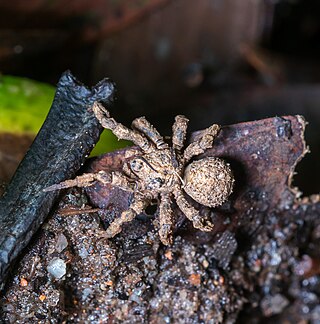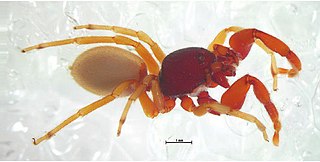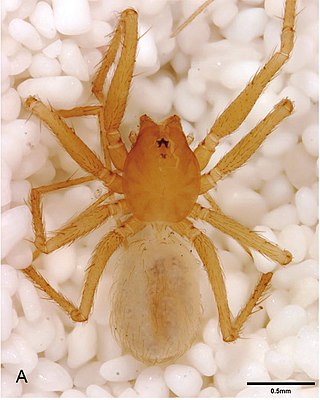
Leptonetidae is a family of small spiders adapted to live in dark and moist places such as caves. The family is relatively primitive having diverged around the Middle Jurassic period. They were first described by Eugène Simon in 1890.

Idiopidae, also known as armored trapdoor spiders, is a family of mygalomorph spiders first described by Eugène Simon in 1889. They have a large body similar to tarantulas.

Barychelidae, also known as brushed trapdoor spiders, is a spider family with about 300 species in 42 genera.

Migidae, also known as tree trapdoor spiders, is a family of spiders with about 100 species in eleven genera. They are small to large spiders with little to no hair and build burrows with a trapdoor. Some species live in tree fern stems. They have a Gondwanan distribution, found almost exclusively on the Southern Hemisphere, occurring in South America, Africa, Madagascar, Australia, New Zealand and New Caledonia.

Cyatholipidae is a family of spiders first described by Eugène Simon in 1894. Most live in moist montane forest, though several species, including Scharffia rossi, live in dry savannah regions. They occur in Africa, including Madagascar, New Zealand and Australia, and one species in Jamaica. Most members of this family hang beneath sheet webs. Fossil species occur in the Eocene aged Bitterfield and Baltic Ambers, suggesting a wider geographic distribution in the past.

Mysmenidae is a spider family with about 135 described species in thirteen genera. The family is one of the least well known of the orb-weaving spiders because of their small size and cryptic behaviour. These spiders are found in humid habitats such as among leaf litter and in caves.

Cryptothele is a spider genus with 10 described species, now placed in the family Zodariidae.

The Palpimanoidea or palpimanoids, also known as assassin spiders, are a group of araneomorph spiders, originally treated as a superfamily. As with many such groups, its circumscription has varied. As of September 2018, the following five families were included:

Moggridgea is a genus of spiders in the tree dwelling family, Migidae. The genus was first described by Octavius Pickard-Cambridge in 1875, who named the genus after naturalist John Traherne Moggridge.

Tarantulas comprise a group of large and often hairy spiders of the family Theraphosidae. As of August 2022, 1,040 species have been identified, with 156 genera. The term "tarantula" is usually used to describe members of the family Theraphosidae, although many other members of the same infraorder (Mygalomorphae) are commonly referred to as "tarantulas" or "false tarantulas". Some of the more common species have become popular in the exotic pet trade. Many New World species kept as pets have setae known as urticating hairs that can cause irritation to the skin, and in extreme cases, cause damage to the eyes.
Chisoneta is a genus of North American Leptonetids that was first described by J. Ledford in 2011.
Darkoneta is a genus of spiders that was first described by J. M. Ledford & C. E. Griswold in 2010.
Montanineta is a monotypic genus of North American leptonetid spiders containing the single species, Montanineta sandra. It was first described by J. Ledford in 2011, and has only been found in the United States.

Tayshaneta is a genus of North American leptonetids that was first described by J. Ledford in 2011.
Goloboffia is a genus of spiders in the family Migidae. It was first described in 2001 by Griswold and Ledford to accommodate the single species Goloboffia vellardi, found in Chile. In 2019, more species were described. As of September 2020, five species were accepted:

Pasilobus is a genus of orb-weaver spiders first described by Eugène Simon in 1895.
Namaquarachne is a genus of South African araneomorph spiders in the family Phyxelididae, and was first described by C. E. Griswold in 1990.
Uduba is a genus of Malagasy araneomorph spiders in the family Udubidae, first described by Eugène Simon in 1880.












